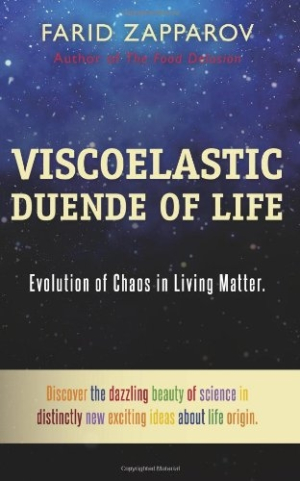Viscoelastic Duende of Life
Evolution of Chaos in Living Matter.
Viscoelastic Duende of Life is an impressively thoughtful alternative to the cut-and-dried theory of natural selection.
Viscoelastic Duende of Life: Evolution of Chaos in Living Matter. presents new theories, founded in biochemistry, about how life arose from the inorganic elements with which Earth began its existence. The depth of Farid Zapparov’s research and his ability to contextualize scientific arcana make Viscoelastic Duende of Life an interesting, if not riveting, pop science read.
The primary thesis is that the primordial soup was much more like primordial Jell-O in consistency. Zapparov presents a thorough, intellectual hypothesis about how the original elements that become organic compounds interacted and evolved within a gel that was both viscous and elastic—hence “viscoelastic.”
Beginning at the infancy of the planet, the book describes the cyclical chemical reactions, or “oscillations,” that could have given rise to the components of cellular life within gels. Instead of focusing on genetic evolution, Zapparov, whose studies include polymer fields, argues that molecular evolution kick-started the appearance of life in the universe. As the text progresses, the author augments his thesis by pointing out that various biological systems, including the brain, also rely on properties associated with viscoelastic gels.
Though the vocabulary easily trumps the average dictionary, Zapparov’s style both engages and persuades. His writing is eloquent and interesting, even when the technical level of the subject goes beyond the presumed comfort of the average reader. A discussion of evolution in chapter thirteen, called “Viscoelastic autocatalysis and self-assembling,” throws around terms like “microstates” and “porous-elastic medium,” but still manages to clearly convey the possibility of early “mutant” RNA molecules created by fluctuating chemical reactions within a gel-like substance. Granted, further vocabulary research is very often helpful, but once that has been accomplished, there is no question of Zapparov’s meaning.
As an alternate perspective on evolution, Viscoelastic Duende of Life is an interesting alternative to the theory of natural selection. For the engaged reader possessed of even a distant background in chemistry or biology, detours to outside source material may be necessary, but minor, inconveniences. Armchair scientists and chemistry students will find much to like here, whether or not they agree with Zapparov’s theories. However, readers without a scientific background or a keen amateur interest in chemistry should definitely consider steering clear. This daunting text assumes the maximum of its audience.
The book’s excellent bibliography and thorough citations support Zapparov’s statements and open the door to further investigation. The text doubles as a fine review of theories about the origin of life from a somewhat unusual perspective, as well as an interesting window into the complexities of chemical reactions that occur within semi-solid substances.
Whether or not Viscoelastic Duende of Life rocks the scientific community, it is a book that will entertain science-minded readers.
Reviewed by
Anna Call
Disclosure: This article is not an endorsement, but a review. The publisher of this book provided free copies of the book and paid a small fee to have their book reviewed by a professional reviewer. Foreword Reviews and Clarion Reviews make no guarantee that the publisher will receive a positive review. Foreword Magazine, Inc. is disclosing this in accordance with the Federal Trade Commission’s 16 CFR, Part 255.

